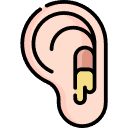With five kids, I know what it’s like to worry about whether a cranky baby is just teething or if it’s something to be concerned about. Nobody wants to take unnecessary trips to the doctor, especially with a cranky baby in tow, but you don’t want to risk your child’s health either.
To help you make the right decision, we’ll provide a quick rundown of the signs of teething vs. sickness, explain what you can do in each case, and give you the answers to the question we hear most often.
Key Takeaways
- Signs of teething include gnawing on everything, drooling, teething rash, crankiness, and less interest in solids.
- Signs of an ear infection include fever, refusing food and milk, vomiting, diarrhea, runny nose, cough, inconsolable behavior, and rashes.
- If your baby is teething, you can help them by offering cold washcloths, teething rings, or teething biscuits, and wiping excess drool from their face.
- If you think your baby has an ear infection, consult a doctor, offer fluids and foods, allow them to sleep when needed, and use warm compresses to soothe the pain.
Signs of Teething
These are the most common signs of teething, followed by what you can do to help your teething baby.
Gnawing on Everything
The uncomfortable pressure of a tooth emerging through the gum is relieved by counter pressure.
As a result, your teething baby will be jamming whatever they can in their mouth and biting down on it. So watch your fingers! Having a teething baby chewing on your digits can be surprisingly painful.
Drooling
Saliva keeps the mouth lubricated and the gums softened. It also allows food to go down more easily. The salivary glands go into overdrive during teething, but your baby hasn’t yet developed complete control of the muscles in the mouth. This lack of control results in all of that dribble escaping (1).
Teething Rash
All of that extra drool can cause the cheeks and chin to chap and chafe. Your baby may develop a red, slightly raised rash with tiny red bumps. This usually occurs on the chin, cheeks, neck, and/or chest.
Teething rash may come and go for much of the time your child is teething (2).
Crankiness
All babies cry and get fussy from time to time. But over time, you begin to develop a feel for the cause of their crankiness. If your child is rested, fed, dry, and otherwise well but is uninterested in play and seems unsettled for no particular reason, it could be because they are teething.
Less Interest in Solids
Once your baby has started eating solids, a sudden lack of interest from a previously enthusiastic baby could be a sign their mouth is sore. Especially if this refusal is intermittent.
However, teething babies who have “gone off” solids are generally still interested in breast or bottle feeding.
A Slight Increase in Temperature
Babies do not develop fevers when teething. Studies show there may be a slight rise in temperature the day before, the day of, and the day after the eruption of a new tooth. However, this doesn’t rise to the level of a fever, which is a temperature of 100 degrees Fahrenheit or above (3).
Fever Alert
If your baby spikes a fever over 100 F, don’t assume it’s from teething. It’s best to speak with your child’s doctor or pediatrician to seek out any underlying illness causing an elevated temperature.
Rubbing the Face or Tugging an Ear
It can be difficult for anyone to pinpoint the exact site of discomfort they are experiencing. Combine that with a baby’s lack of muscle control, and they can end up rubbing their face or mouth and tugging at their ears as they attempt to relieve their discomfort.
Signs of an Ear Infection
Some symptoms or behaviors are more likely to be the result of an ear infection or other illness.
Fever
We develop fevers when our body is fighting an infection. If your baby has a temperature of 100 F or above, they have a fever (4). For babies that are 3–6 months old, if they have a temperature of up to 102 F and seem sick, or if their temperature registers more than 102 F without other symptoms, see a doctor.
Refusing Food And Milk
A baby refusing or cutting short a single feed without other symptoms is likely fine. If your baby refuses multiple feeds or has other symptoms such as a cough, a runny nose, or an upset stomach, there’s likely something else going on.
Vomiting, Diarrhea, Runny Nose, Or Cough
A teething baby may cough or gag slightly from time to time due to excess saliva in their mouth. If your baby has a runny nose or a cough, if they’re experiencing vomiting or diarrhea, if they aren’t wetting their diapers, or if they have any other symptoms, they likely have an illness.
Inconsolable
All babies have occasional fussy periods when nothing you do seems to help. Although it’s difficult to put into words, sometimes you just know that your baby is inconsolable because something is wrong. Trust your instincts. If you think your child is dealing with more than typical crankiness, see your doctor.
Rashes
If your baby develops a rash anywhere other than their face, chin, or upper chest, then it is unlikely it was caused by teething. If you are unsure, press a glass against the rash. If it doesn’t disappear under pressure, contact your child’s doctor.
If Your Baby Is Teething
There are plenty of ways to help your teething baby.
- Teething doesn’t usually cause a great deal of pain. A carefully measured, weight-appropriate dose of a baby painkiller is helpful but check with your doctor before you administer a painkiller for the first time (5).
- Gently wipe excess drool from your child’s face, and if they experience chapping, rub a little vaseline on the area to protect the skin.
- Wet a washcloth with cold water, wring it out, fold it, and hold it for your baby to chew.
- Teething rings and age-appropriate teething toys cooled in the fridge can help soothe gums.
- If your child eats solids, a hard teething biscuit can be helpful.
Avoid:
- Medicated teething gels.
- Amber necklaces.
- Rubbing alcohol on gums.
If You Think It’s an Ear Infection
If you think your little one has an ear infection, if they have other symptoms, and if symptoms don’t seem to resolve in a day or two, see a doctor. At home, you can:
- Give a weight-appropriate dose of a baby painkiller but check with your doctor before the first time you use it (6).
- Offer foods and fluids frequently to avoid dehydration.
- Don’t fret about routine. If you have the luxury of being home with your baby, let them sleep when they like.
- A warm compress against the ear can soothe the pain.
- A pillow or two under your baby’s mattress can elevate the head and help them sleep. However, do not put a pillow directly under your baby’s head.
Frequently Asked Questions
These are the questions we’re asked most often about teething or ear infection.
Is It Teething or an Ear Infection?
We all worry about our babies — it’s part of the parenting job description, but not knowing why your baby seems to be suffering is never easy. This information will help you determine whether your baby has an ear infection, is teething, or is otherwise unwell.
It’s important to have confidence in your ability to care for your child, to recognize when they are not feeling well, and to listen to your gut when you feel, against all other evidence, that something’s wrong.











